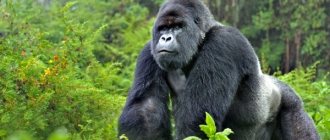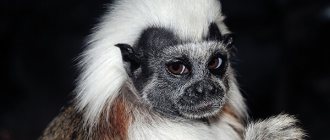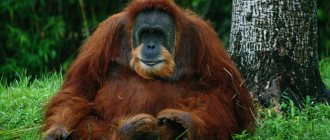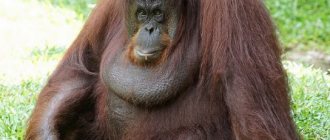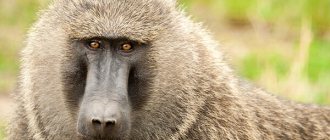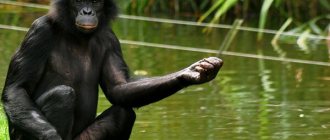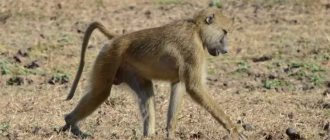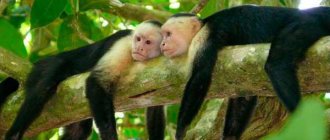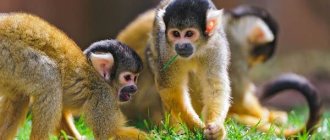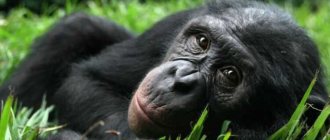The genus of the family of hominids of the primate order called chimpanzees includes two species: the common chimpanzee (Pan troglodytes) and the dwarf chimpanzee (Pan paniscus), or bonobo. They are endangered and are found in the western and central regions of the African continent. The average height of adult males reaches 150 cm, females - 130 cm. Chimpanzees live mainly in groups, which consist of 10-12 individuals. Adult chimpanzees leave their group and create a new one. Primates spend the night high in the trees.
Description of chimpanzee
The height of adult male chimpanzees reaches 170 cm, weight – 70 kg.
Females are always smaller than males. The brain volume of these primates is approximately 25-30% of that of a human. When walking, animals do not rest on the palm, like other four-legged animals, but on the upper surface of the fingers. Apart from the face and inner parts of the limbs, the entire body of the chimpanzee is covered with long, coarse, dark fur. — Advertising —
Chimpanzees have well-developed facial muscles, and when communicating with each other they make about 30 different sounds and actively use facial expressions, hand gestures and body postures.
Monkey habitat
This group of mammals lives on all continents except Antarctica. They are mainly found in Asia, Africa and South America. Primates prefer to live in the tropics or subtropics. They are not found on the island of Madagascar. In South America, a huge number of different species of monkeys live in the Amazon basin.
These animals prefer warm climates and do not tolerate cold well. But there are species that have adapted to life at low temperatures.
Common chimpanzee subspecies
The following subspecies are known for the common chimpanzee:
- Black-faced chimpanzee (Pan troglodytes troglodytes) - found in Cameroon, Central African Republic, Equatorial Guinea, Gabon, Congo;
— Advertising —
- Western chimpanzee (Pan troglodytes verus) - native to Guinea, Mali, Sierra Leone, Liberia, Ivory Coast, Ghana and Nigeria;
- Pan troglodytes vellerosus – inhabitant of Nigeria and Cameroon;
- Schweinfurth's chimpanzee (Pan troglodytes schweinfurthii) - distributed in the Central African Republic, southern Sudan, Congo, Uganda, Rwanda, Burundi, Tanzania and Zambia
Additionally, the bonobo, or pygmy chimpanzee, was described as a distinct species in the early 20th century. In size it practically does not differ from the common chimpanzee, but is less dense in build.
Population and species status
Common and pygmy chimpanzees are listed as endangered on the International Red List. Despite the fact that chimpanzees reproduce without problems in captivity, maintaining the total number of them living in the natural environment is a rather difficult task. The number of individuals living in the wild is falling from year to year.
In the territories of some countries, the decline in the number of chimpanzees is so critical that over the past few decades the number of individuals has decreased by an order of magnitude. This disappointing data is due to a number of reasons. The first reason is illness. For example, as a result of Ebola, chimpanzee numbers dropped by almost 30 percent. The next reason is human economic activity, and as a result, there are fewer and fewer chimpanzees in the world.
According to various estimates, there are from 150 to 300 thousand individuals in the world that live in scattered territories of the African continent. We may not see a significant part of these outbreaks in the near future, as they will simply die out.
There are even fewer pygmy monkeys, and their number is about 30-50 thousand individuals. Over the course of one year, the number of pygmy monkeys decreases by an average of 2.5 percent. The number has declined especially noticeably over the last century. At the beginning of the twentieth century, according to various estimates, at least 1 million individuals lived on our planet, and some experts believe that there were about 2 million.
Interesting moment! Chimpanzees are distinguished by the fact that they use various improvised means in their life, and sometimes make such means themselves. To store moisture for themselves, they dig holes and also sharpen branches to hunt more efficiently. Such skills are passed on from generation to generation. According to scientists, the activity of chimpanzees is at a level that can be used to predict the course of the process of human evolutionary development.
Chimpanzee behavior
Chimpanzees have highly developed social behavior, each group or community is characterized by a strict hierarchy.
The dominant male is known as the alpha male. He has the highest social position, he rules the community, maintains order, and resolves disputes. Moreover, he is not always the largest and strongest, but as a skilled manipulator he controls everything that happens between his relatives. Interestingly, dominant males often have companions who help them fight for power. Alpha males try to look powerful and threatening, walking with their bodies puffed out and their fur fluffed up. It is important for them to maintain their position and constantly intimidate other males. Subordinate chimpanzees, on the contrary, make respectful gestures and in every possible way show their respect for him. Females in the community also have their own hierarchy, which is controlled by one of them. Often the highest position is inherited. For both males and females, higher position in the group provides access to better food and mating privileges. Often it is the females who choose the alpha male. Therefore, males, in turn, try to earn recognition and approval from them. Moreover, females can displace an unwanted male and prepare a replacement for him.
When chased, these primates climb trees and make sounds reminiscent of barking. Chimpanzees can copy the actions of other monkeys, often imitating stronger relatives.
Chimpanzees are quite often highly aggressive. While fighting for the best territories, food and resources, and even in order to get rid of competitors, they can kill each other. At the same time, chimpanzees can grieve for deceased relatives and community members.
Nutrition
Chimpanzees are considered omnivorous primates. Their diet includes both food of plant and animal origin. They need to eat often and in large quantities, since they lead a very active lifestyle and spend a lot of energy for this. It is also important for them to constantly maintain a certain supply of subcutaneous fat; it helps them survive during periods of autumn rains or drought.
Chimpanzee eats apples
These monkeys mainly feed on fruits and berries, roots and leaves of trees. Since chimpanzees are not afraid of water and are excellent swimmers, in reservoirs they deftly catch shellfish and small river animals. Not averse to eating small animals and insects.
There are known cases when, in the absence of other food, these primates ate their own kind, and even fellow tribesmen.
Chimpanzee reproduction
Chimpanzees reproduce throughout the year. When females go into heat, they take turns mating with several males in their community. In this case, fights do not occur between males, since females make their choice. The menstrual cycle of females resembles that of women. The duration of pregnancy is 7-8 months, after which one baby is born, and occasionally twins are born. The cubs are born almost naked and completely helpless. For the first 5 months of life, females wear them on themselves. The babies hold on to the fur on the mother's chest, and the female holds them with her hands. Then they move onto their backs. At six months they begin to take their first independent steps, but mothers closely monitor their babies’ attempts. At the age of 1 year, the weight of a young chimpanzee reaches 8-9 kg. Babies stay with their mothers until they are 3-4 years old. And then they begin to live independently.
Use of tools
Chimpanzees use a wide variety of tools: brooms, leaf sponges, twigs used to extract marrow from bones, and sticks and stones used as hammers and anvils.
Two types of food (social insects and fruits) generally require the use of tools, although different populations use them differently. Most social insects have a strong defense (poison) that can be dealt with by using sticks or soft stems. Chimpanzees make smooth, durable sticks 60 to 70 centimeters long (enough to reach stray ants), lower them into an open nest, wait for the ants to crawl on them, and then shake the insects into their mouths before they can sting. In order to achieve the desired size and shape, the monkeys bite off a blade of grass and push it into the hole of the termite mound: the soldiers bite the grass stalk and hold on to it for a long time, during which time the chimpanzees manage to pull them out and eat them. Sticks are also used to widen holes in tree trunks to reach termites or wood ants.
Chimpanzee communication
Another type of food that tools are used to eat are hard-shelled fruits, too hard for chimpanzees to bite through. Sticks and stones weighing up to 1.5 kg are used to break the shell (or peel) of these fruits, sometimes they are thrown onto stone platforms that serve as anvils. In the middle of these platforms you can often see rounded depressions, which suggests that chimpanzees have been using them for a very long time (centuries).
But tools are used not only for obtaining food. During threatening demonstrations, adult males throw sticks or stones weighing up to 4 kg or more. There was also one recorded case of a projectile being used during a hunt: a male pig hit an adult pig from a distance of five meters and scared it so much that it ran away and allowed him to grab the piglet.
Young chimpanzees have to observe, study and practice for years to master the use of certain tools, especially the hammer and anvil. Different populations use them differently - the most striking differences are those transmitted through social learning (called "cultural traditions" in chimpanzees). Bonobos also use tools, but not as varied and not as often.
Chimpanzee at the zoo
Interesting facts about chimpanzees
- Chimpanzees are the closest relatives of humans. Our gene pool coincides with theirs by 98.7%. It is believed that the evolutionary paths of humans and chimpanzees diverged about six million years ago.
- A new era in chimpanzee research began when Jane Goodall began studying these primates in their natural habitat in Tanzania. She managed to overcome the mistrust and caution of primates, and when they stopped fearing her, she was able to make many interesting discoveries. In particular, it has been proven that chimpanzees themselves make simple tools and are easy to learn.
- The first living chimpanzee was brought to Europe in the 17th century.
- Common chimpanzees Ham and Enos visited space (Mercury program).
